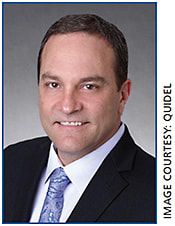Industry Insider is a timely chat with an ophthalmic industry thought leader.
Robert Bujarski, SVP, commercial operations, North America, has been with Quidel for 15 years.
Ophthalmology Management: InflammaDry tests for dry eye using MMP-9 levels. What is the advantage of using this measurement?
Robert Bujarski: The MMP-9 biomarker is an excellent indicator of inflammatory dry eye disease. With its high sensitivity and specificity (81% and 98% respectively, as reported from FDA trials), InflammaDry is a very accurate tool to help guide therapeutic decision making. The benefit of detecting elevated levels of MMP-9 is that oftentimes clinical signs do not correspond with symptoms. Therefore, early detection of MMP-9 with InflammaDry can allow for an optimal treatment program. With dry eye being multifactorial, our test, combined with other diagnostic tools, provides the physician with the best overall information to better treat their dry eye patients.
OM: Why did Quidel expand into the eye-care space?
RB: If you step back and think about Quidel’s identity as a company, our focus is in vitro diagnostics (IVD). We think IVD testing in the ophthalmic space will continue to grow as new therapies and treatments are developed, and we believe the tear film specifically is an interesting sample site that will prove to be more and more valuable.
As to our later plans in that space, if you look at how we intend to grow in eye health, it will be both through distributing our own products and leveraging our sales and marketing team to bring on exceptional products from third parties, as we did with the InflammaDry and our SMTube dry eye diagnosis tool. Both of those approaches will be part of our growth strategy as we continue to carve out a new space for Quidel in eye care.
OM: You have been with Quidel for the past 15 years. How has the company evolved in that time?
RB: Perhaps the most extensive growth is in our R&D department, where we have increased R&D spending meaningfully since 2010. Today we spend between $50 million and $60 million annually.
Of course, we’ve grown in staff as well, starting at approximately 250 employees when I joined, to now about five or six times that.
And our portfolio has increased. There were three key products when I joined, in the fields of flu, strep and pregnancy. Now we’re in areas ranging from infectious disease and cardiology to toxicology and eye health, which we entered a little over 2 years ago.
OM: What is Quidel’s philosophy when it comes to developing ophthalmic products?
RB: I think it’s similar to the other product spaces we’re in, in that we focus on rapid, point-of-care decentralized testing. To accomplish that, you need to have products that are fast, easy to use, cost-effective and perform well.
Decentralized products are also important to us, so that clinics can complete tests inside their own walls without help from an outside source, such as a third-party lab. OM









